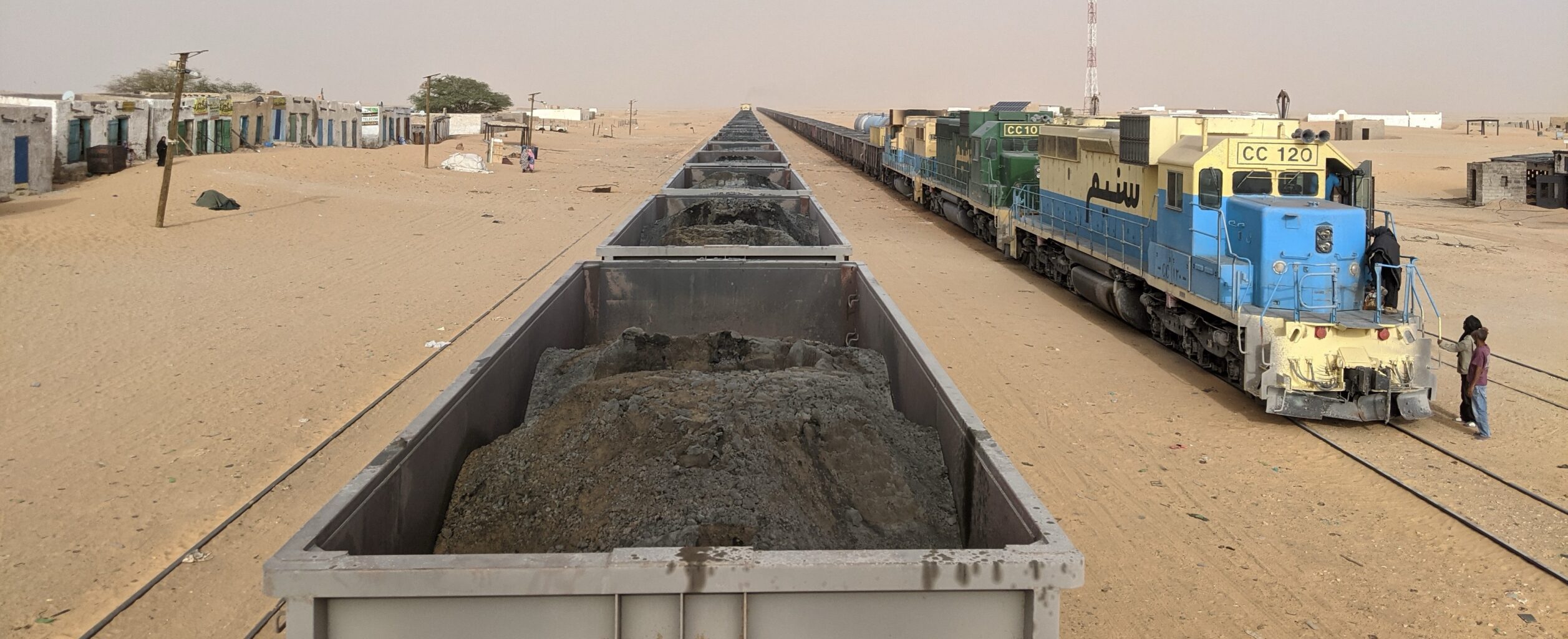We need to start with the boring stuff because in the end, it’s actually what matters most. The Société Nationale Industrielle et Minière (SNIM) is the backbone of Mauritania’s economy. Operating in the remote Tiris Zemmour region, it extracts and transports iron ore along a 700 kilometre railway to the port city of Nouadhibou. In 2022, iron ore accounted for about 30% of the country’s state revenues and 37% of national exports, making it a critical source of foreign exchange and economic stability. This is not just a train journey through the Sahara. It is the lifeline of a nation’s economy.
A Real Adventure
Riding through the Sahara Desert on the back of the iron ore train in Mauritania was an epic experience. We didn’t need to post videos of us doing backflips. Making a sandwich was on our highlight reel. So was watching the ISS zip past. Getting rocked to sleep, wrapped up in a sleeping bag as the train pushed relentlessly towards the coast.
We’ve been really lucky to connect with travellers who are in it for the experience. Taking a photo was an opportunity to share an amazing moment with friends, and we haven’t had too many who treat social media disrespectfully.
Our mantra has always been, respect yourself, respect your fellow travellers, and above all else, respect our hosts.
When Did Adventure Become a Performance?
I have been thinking about that a lot. About how adventure has changed. It used to be about discovery, seeing a place for yourself, feeling it, being part of it in some small way. Now, too often for some people, it is about presentation. It is about how it looks, how it plays online, how many people react to it. The value of an experience is no longer in the doing but in how it is received.
I am back in Mauritania, about to run another tour in this incredible place. My first trip here was in 2005, and I have been returning ever since. Since the end of COVID, we have been running trips here every year. I do not claim to be an expert on Mauritania. We partner with a local company for that. But I have developed a deep appreciation for this country and its people. It is not just a highlight for the travellers we bring here. It is a highlight for us, too.
The Iron Ore Train: From Adventure to Legend
But let’s talk about what brought so many others here. The iron ore train.
Somewhere along the way, the iron ore train became the stuff of legend. Thanks to YouTubers, TikTokers, and Instagrammers, it has been portrayed as the wildest, most dangerous, even illegal adventure on the planet. As a company, I have to be honest. We benefited from this hype. We sold trips based on this promotion. But the truth is, it was built on lies. Not life threatening lies, but the kind of clickbait exaggerations content creators thrive on. Sitting on top of the iron ore, eating Pringles, and staring into the desert does not get the clicks. It had to be death defying, a story of intrepid explorers discovering the essence of true adventure.
The Making of a Social Media Myth
For years, SNIM, the company that operates the train, turned a blind eye to locals riding it, viewing it as a form of social outreach for those who could not afford transportation. Tourists saw this and thought it looked like a cool adventure. Next came the uniform. Ski goggles and a seche tied tightly around the head. A few pictures on Facebook, maybe a YouTube video. Then came the content creators, ready to hype it to the next level. The Sahara Desert became their stage, and the narrative became, “I illegally hitchhiked the most dangerous train in the world!” Truth be damned. The story was all that mattered.
The Consequences of Exaggeration and Hype
Here is the problem and in hindsight, it is just so damn frustrating. SNIM’s management saw the increasingly outlandish content online. Hashtags and location services put it right in front of their eyes. They then had to deal with the fallout.
Stakeholders questioned why they allowed tourists to spread this nonsense online, exposing the company to liability if someone got hurt or worse. What has been truly lost in all this is that the train is carrying iron ore. Two hundred carriages or more per train, maybe three trains a day, racing from the mines near Zouerat to the port in Nouadhibou.
Think for a second about the financial losses if the operation is delayed. Can we really expect a company to risk disrupting the whole operation because some tourists choose to make the train their playground? Maybe they could have tolerated videos of dirty tourists eating biscuits and huddling against the cold, but TikTokers dancing and doing backflips while falsely claiming to illegally hitchhike through lawless Mauritania on the ‘most dangerous train in the world’ was always going to be too much.
And now, because of all this sensationalism, simple travellers who just wanted to experience the iron ore train without the hype are missing out. Those who would have appreciated the journey for what it truly was have been robbed of the opportunity.
The Truth about the Iron Ore Train Today
Our local partners have spoken directly to the management of the company operating the train since the latest ban has taken place. I can’t be clearer. Tourists are NOT banned from riding the iron ore train. SNIM however has banned tourists from riding in the iron ore wagons. A group were removed from the train this week by SNIM and the gendarmerie were there as well. There are passenger cars at the back of the train for people, and that is where they expect travellers to be.
We should be incredibly thankful that SNIM is even offering this service. They have even discussed adding more passenger cars to accommodate demand, but as our cancelled bookings attest to since we removed the train from our tours, that probably will not solve the issue. Because for too many people, it is not just about the train or the desert. It is about getting that shot.
As I write this, people are coming here to catch the train or saving their money for the chance to get here and do it for themselves. Please understand this is not meant as a lecture, but people need to know the truth and not another distorted version of an imagined reality. Online, self proclaimed experts are still looking for likes by sharing their so-called secret sauce for riding the train, even if they only did it once two years ago. There are guides who know how to make it happen, and yes, it is possible.
There are companies and individuals still promoting their tours with the train on the itinerary and some even going as far as saying they know there is a ban, but that they know how to get around it. The train is massive, and opportunities exist, but unless you are planning on riding in the passenger cars, getting around it means sneaking onto the train and hiding from the authorities and putting your local guides at risk. If you are caught, you will be removed, and I suspect the penalties will become more severe over time. Penalties including actual jail have been threatened to tour operators and guides who assist people in riding in the iron ore wagons. Hopefully people stop to think about that when they make some guide who is desperate for work complicit in their attempts to get those likes
A Night in the Sahara: Remembering What Matters
There is so much more to Mauritania than the iron ore train ,experiences that remain untouched by the imaginative filters of content creators. Tonight, we are in a tiny village in a corner of the Sahara Desert. Our group came to see Mauritania, and while they were curious about the train, it wasnt a dealbreaker when we told them we wouldn’t be doing it.
We danced with local women as they played a drum made from an old pot with a tyre tube stretched over it. Another drum was an upside down bowl we had used to serve rice just 20 minutes earlier. The light for our impromptu show came from a nearly full moon and the fire they were using to bake bread.
We clapped until our hands hurt, danced, laughed, and were laughed at for our lack of rhythm. Not one of us took out a phone. I think we all realised how special the evening was. Trying to film it would never have captured it clearly, and might have upset someone or scared them into the shadows.
A Personal Reflection on Social Media and Living an Adventurous Life
I cannot help but wonder. What happens when the pursuit of the perfect story overshadows the authenticity of the experience? What happens when adventure becomes a performance rather than a personal journey?
I have been running tours in Africa for over 25 years, I do not pretend to have the answers but to me it is way past time to rethink how we approach adventure. I think we need to return to prioritising the experience over the content. We need to respect the places we visit and the people who call them home. We need to stop using everyone around us as extras in our online stories, whether they have given consent or not. We need to remember that not every moment needs to be shared on Instagram. And we need to start calling out these travel influencers who peddle lies for likes.
Personally, I am disappointed that I have allowed social media to colour the way I experience things. I am trying my best to relearn that, nearly always, the most meaningful adventures are the ones we do for oursleves. We are so lucky to have access to Social Media. To be able to share our stories. But we all have a responsibility to make sure our travel stories are real, that we don’t exploit the places we are guests in, and that when we hit post, we don’t screw it all up for everyone else.


0 Comments